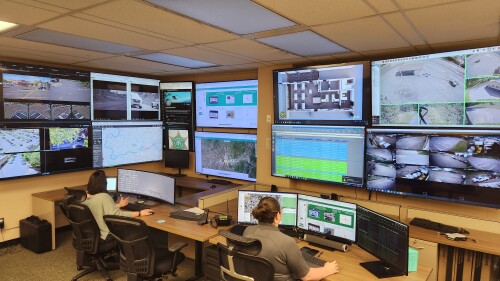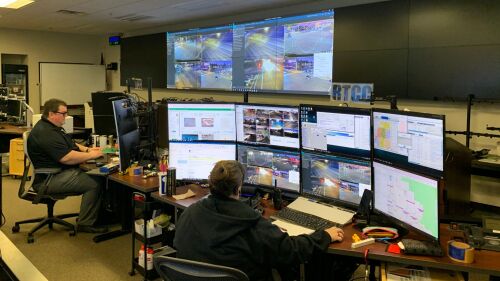By Chris Bolin
Greeley Tribune, Colo.
GREELEY, Colo. — A $2.4 million police initiative could change the nature of 911 responses in Greeley as soon as this year.
Greeley City Council this week gave first approval to appropriate public safety tax funds to build a real-time information center for the Greeley Police Department.
Greeley Police Chief Adam Turk saw the need to leverage the department’s technological resources to become more proactive in its policing after assessing how the department uses its technology about 18 months ago. That led Turk and Cmdr. Tanya Gutierrez to present about the real-time information center to Greeley City Council at its March 14 work session.
Turk told the council police administration has historically been good at acquiring new technologies but remained more reactive than proactive. By combining these technologies under one roof, police could become more efficient in their response.
“We want to be a leader in northern Colorado,” Turk told the Tribune. “We want to because we’re going to see wins and see the investment pay dividends really fast.”
Turk estimates construction will cost about $2.3 million up front and that the center will require about $700,000 a year in operating costs — a number he expects to rise with inflation and as the center grows to keep up with Greeley’s population. A second reading of the appropriation is scheduled before city council at its Tuesday, April 2 meeting.
The department is already in the process of finding a location. Turk said they are looking at existing city-owned spaces that are available or may come available in the next six months. From there, it’s just a matter of renovating the building and moving in. Officials hope it will go live in the third quarter of this year.
One of the features Turk is most excited about the real-time information center is the increased capacity for drones. Greeley police already use drones — and have for several years now.
“What we can do with drones right now from the public safety standpoint is just amazing,” he said. “Instead of sending officers into a backyard with obstacles and not knowing, we can just put a drone above the area, seek out the heat source and identify where the source is.”
The possibilities are endless, he said — or at least as endless as the budget allows.
Turk hopes with the real-time information center — and possibly remote launching stations spread throughout the city — police will be able to deploy drones even faster.
When someone calls in a major traffic crash on U.S. 34 , Turk said as an example, police are typically responding with at least two officers and a supervisor, two fire engines and an ambulance. By flying a drone there in half the time and discovering it’s only a minor crash, police could better use their resources, he said.
Severance Police Chief Ken Chavez said technology has significantly changed policing over the past few decades. In fact, it’s changed a lot over just the past decade.
“We have found ourselves at a point now where we cannot operate without technology,” Chavez said. “It’s part of our profession. Part of the way we serve the public.”
From simple upgrades in cameras to being able to hear a gunshot and triangulate its location — that technology can take a number of different forms.
Chavez said some of the biggest technological advancements in his time as an officer have come in police vehicles.
“When I started in a police car — you know, in the 70s — it was a light, a siren and a radio,” he said. “Now we have computers in the cars. We have dash cameras. We have radar and lidar for speed detection. It’s a highly technical piece of equipment.”
Cruisers nowadays are equipped with automated license plate readers, for example. The technology reads license plates that come into view of the vehicle’s dash camera and alerts the officer if the vehicle has been reported stolen or any associated warrants.
One of the most useful pieces of technology in helping police solve crimes, Chavez said, is something every officer, and just about every civilian, carries with them: a cellphone. On the most basic level, cellphones allow officers to make calls without having to drive all the way back to the station and to access information online quickly. On a deeper level, they help solve a lot of crimes.
“We use cellphone data a lot in crimes,” Chavez said. “Tracking where people were by their cellphone, what time they may have been at the scene, when did they leave.”
Not all police technology consists of familiar, everyday tools, of course. Chavez, who spent more than 40 years with the Denver Police Department, highlighted ShotSpotter — an array of microphones deployed around Denver that detects a gunshot and triangulates its location to within 25 feet.
“You can quickly listen to the recording to hear what kind of gun and how many shots were fired,” Chavez said. “And it enables officers to get over there quickly and recover shell casings, which is a critical part in identifying the firearm utilized and who it was associated with.”
Turk likened the real-time information center to the eyes of the community and the Weld County Regional Communications Center, or dispatch, to the ears.
Turk used an example from one of the cities they studied that already has a real-time information center as to how big of an impact this technology can have — and how the center can work with public safety systems already in place.
A mother called 911 to report her 4-year-old had been missing for 30 minutes from the park they were at, giving a description of the child and the clothing the child was wearing, he said.
While the mother was on the phone with dispatch, someone listening in on the call at the real-time information center pulled up video from the park, rewound it 30 minutes and watched the child walk across the street, down a couple blocks and into a store.
Police were dispatched directly to the store and reunited the mother with her child almost instantly.
“We would’ve sent 20 officers, done canvasses, looked for people that might have cellphone or video footage,” Turk said. “It’s a smarter way to police. And quite frankly that’s the future of policing.”
No matter how advanced technology gets, Turk said, it will never replace officers.
“When people call 911 during the worst day of their lives, they still want an officer to respond,” he said. “Not a drone, not a camera.
“So you still need people, boots on the ground doing the hard work, talking to people. So I look at the future of policing to be more efficient to increase our solvability of crimes to stop them before they happen.”
New and improved
Chavez and his department, which formed in 2019, are having to adapt this year to the need for more boots on the ground, as Severance and neighboring Windsor have new police stations under construction.
At 43,000 square feet, Windsor Police Cmdr. Richard Ziegler said, the new station will be more than double the size of the current building to keep up with Windsor’s swelling population. The site of the new station also has about 10,000 square feet dedicated to expansion down the line.
“Hopefully it’ll be a number of years before they have to do that,” Ziegler said. “But at least there’s some thought put into it that can make it a usable building for years and years to come.”
Ziegler said Windsor outgrew its current station years ago. A training space, a conference area and other parts of the current station that were originally intended for storage have all been converted into offices to accommodate the department’s growth.
“We’re literally busting at the seams,” Ziegler said.
Windsor, which began construction on the new headquarters in August, aims to open the new station in February 2025 . The building — along with off-site improvements — is expected to carry a price tag of $30 million and will include multiple training and development spaces, a large multipurpose conference area, a victim advocates space, both a forensics lab and a forensics garage and plenty of office space.
“It will be a nice facility,” Ziegler said. “And it should allow us to do a better job across the board.”
Severance’s new station will be 4,000 square feet, and, unlike their current building, it will include holding cells, interview rooms and a main lobby that will be open to the public. Demolition of the existing building is set for April 1 , with a groundbreaking ceremony for the new building on April 29 in the same location.
Severance police hope to debut the new station in December.
___
(c)2024 the Greeley Tribune (Greeley, Colo.)
Visit the Greeley Tribune (Greeley, Colo.) at www.greeleytribune.com
Distributed by Tribune Content Agency, LLC.








